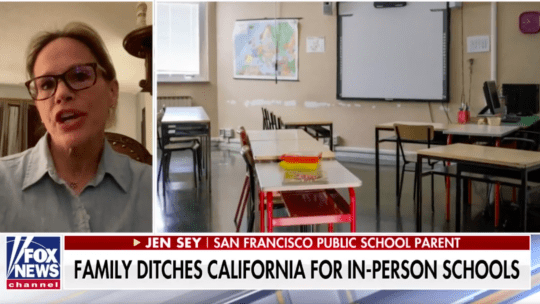
All of social media’s a stage…or is it?
Evidently not, if you want to remain in the C-suite at Levi Strauss & Co.
On Feb. 14, Levi’s now former brand president Jennifer Sey published an essay to journalist and noted cancel culture opponent Bari Weiss’ Substack announcing her resignation.
Twitter pulpit that struck a nerve
Sey’s core revelation: Her promotion to CEO was contingent on ceasing her public calls for reopening schools—and she was pushed out when she refused. Sey wrote Levi's offered a $1 million severance package, but declined it. The deal required signing a non-disclosure agreement.
Like many who are vocal about public policy, Sey’s chief advocacy channel is Twitter, on which the exec has 47,000+ followers. On the topic of schools reopening, Sey’s followers, like the nation, are divided—many expressed support, while “anonymous trolls on Twitter, some with nearly half a million followers,” called for a Levi’s boycott unless Sey was fired, she wrote.
Sey also shared her views with reporters, notably on Fox News’ “The Ingraham Angle,” in March 2021. That appearance, Sey wrote, was the “last straw” for fellow Levi’s employees. Sey did not refer to her employer in articles or segments PRNEWS reviewed; on the Ingraham show her lower third reads San Francisco Public School Parent.
“I think it was possible to support my speaking out without sharing all of my views. And in doing so, create a culture that is truly inclusive, where everyone feels they can use their voice & contribute without holding pieces of themselves back." https://t.co/7VEn2CAFC7
— Jennifer Sey (@JenniferSey) February 16, 2022
Personal vs. Corporate Views
Still, as long as your name appears somewhere in the public realm, detractors will find you and call out your employer—just ask Franklin Templeton or the IAC. It’s the communicator’s role to “bring in perspectives from how other organizations have handled different issues,” advises Andrew Gilman, president and CEO, Commcore Consulting Group.
But there are few perfect solutions. “In today’s polarized, cancel culture world, it is very hard to articulate arguments that don’t conform to orthodox thinking,” Gilman notes. “The question is whether they can be discussed in a business setting and whether the individual’s personal views can or should be expressed in the corporate world.”
For Sonia Diaz, founder and president, Zaid Communications, discipline is at the heart of the issue. Policies and corporate communication teams exist "for the primary purpose of ensuring brand integrity, and that requires a lot of discipline at an organizational level," she argues.
"Discipline means adhering to protocols and guidelines that determine who, if anyone, can publicly make statements as an active representative of the company, whether they are personal in nature or not."
She reminds communicators that disclaimers like opinions are my own on a Twitter handle "won’t dissolve your association with the organization." In other words, Sey's role as a top executive is enough of an association.
Business Costs vs. Perceived Reputation
The Levi’s corporate communication team has remained silent, so far, about why Sey departed. It simply stated she resigned, in an email statement to Yahoo! Finance. It reads like a boilerplate “executive management change” release.
Before these decisions are made, it’s crucial that PR pros “have a seat at the table so that issues can be discussed and you can provide a perspective from the communication and reputation perspective,” says Gilman.
For communicators, once the messaging is created "your job is much like a lawyer’s; to reflect the organization’s views and perspectives and craft the message that represents the company decisions,” Gilman adds.
Given Sey’s image as a Wall Street darling, time (and stock prices) will tell whether the Levi’s gamble—that swirling public opinion around Sey outweighed her value to the business—is a sound one.
Purpose over profits—but which purpose?
“On the performance side, Levi’s financial position improved with Sey at the helm, so one cannot easily say that her views hurt company performance,” says Gilman. He also notes the position of the Business Roundtable, of which Levi’s is a member, that a corporation's purpose is larger than creating profits and shareholder value. Gilman asks, “Is a perspective on a community issue from a leader part of that larger purpose?”
On the one hand, Sey views herself as a community activist giving a voice to those without a platform, going so far as to point out inequities in the private and public-school systems in news appearances. On the other, per Gilman, it’s hard to argue that shareholder value over purpose-driven leadership motivaed the decision to release Sey.
There’s little sign of employee activism falling off the list of crisis scenarios soon. So long as social media platforms dominate the realm of personal expression, brand communicators will be forced to handle the fallout.
Sophie is associate director, events content at PRNEWS. Follow her @SophieMaerowitz
